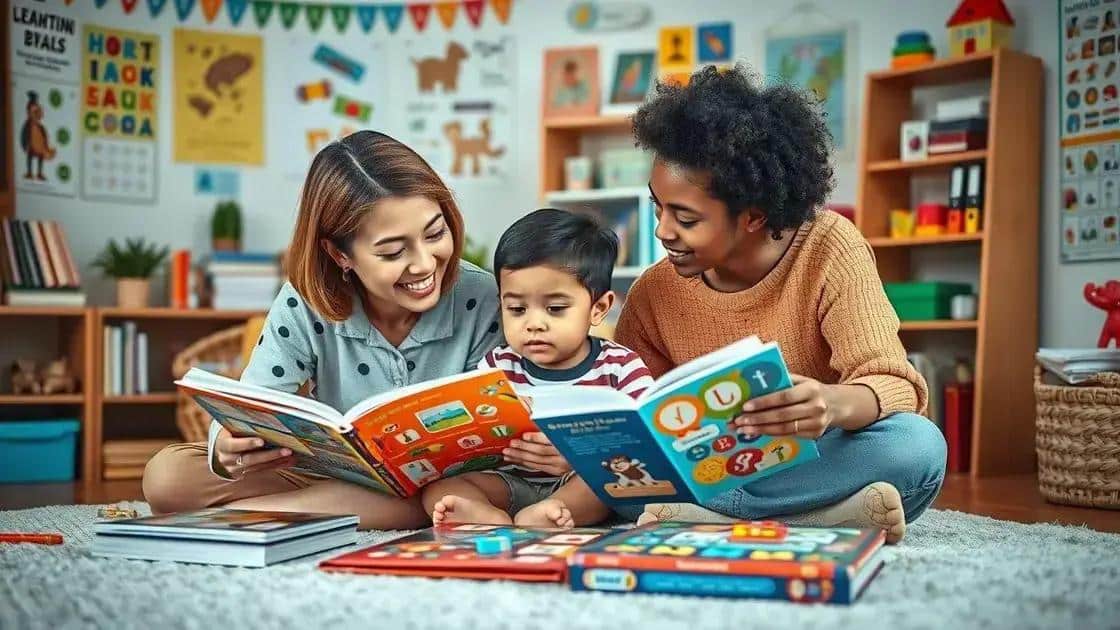Together early childhood learning: fostering growth at home

Together early childhood learning involves parents engaging actively in their child’s education through interactive activities, resources, and clear communication, fostering academic and emotional growth.
Together early childhood learning invites us to explore innovative ways to engage with our little ones. Have you considered how shared experiences can shape their development? Let’s dive into ideas that spark curiosity and creativity!
Understanding the importance of together early childhood learning
Understanding the importance of together early childhood learning is crucial for any parent. This approach encourages us to engage with our children and enrich their development.
Working together during early childhood lays a foundation for lifelong learning. The more we participate in their activities, the stronger our bond becomes. Thus, learning becomes an enjoyable experience for both parents and children.
Key Benefits of Together Learning
When we dive into together early childhood learning, many benefits arise:
- Strengthened Bonds: Collaborating enhances connections.
- Greater Engagement: Children become more involved when learning with a parent.
- Better Understanding: Parents gain better insights into their child’s interests and strengths.
- Shared Success: Celebrating achievements together fosters confidence.
Moreover, facilitating learning experiences alongside your child can take many forms. For example, you might read books, create art, or explore nature. These activities don’t just teach; they inspire curiosity and excitement.
Creating a Supportive Environment
To truly embrace together early childhood learning, it is vital to create an atmosphere where your child feels safe and valued. Encouragement plays a significant role in this setting. When we affirm their efforts, kids are more likely to take risks and try new things.
Involving your child in household tasks can also serve as a learning opportunity. Simple actions like cooking or organizing can teach valuable skills while allowing you to bond. Keep in mind that your enthusiasm will fuel their interest.
Ultimately, the real importance of together early childhood learning lies in the memories created along the way. Celebrating small milestones together not only builds trust but also enriches your child’s emotional and social development.
Activities to enhance learning at home
Engaging in activities to enhance learning at home is a vital part of the together early childhood learning process. These activities not only support educational growth but also foster strong connections between parent and child.
One fun approach is to create a daily routine that includes learning moments. For instance, you might set aside time for reading aloud or exploring educational games together. The key is to make these activities feel natural and enjoyable, so your child looks forward to them.
Interactive Games for Learning
Incorporating interactive games can transform learning into a playful experience:
- Board Games: Choose games that promote math or language skills.
- Online Learning Platforms: Use educational apps that match your child’s interests.
- Puzzles: They enhance problem-solving abilities and cognitive skills.
- Flashcards: Create a fun way to learn vocabulary or numbers.
Also, consider incorporating everyday tasks into learning. Cooking, for example, can teach children about measurements and following instructions. As they help in the kitchen, they can learn about nutrition and even basic science concepts!
Creative Arts and Crafts
Art is another excellent way to enhance learning at home. Through crafts, children can express their creativity while developing fine motor skills.
Gather supplies to create art projects or crafts together. This not only encourages creativity but also helps children learn to follow directions and think critically. You might want to try making collages with different materials or painting on canvas.
Outdoor activities also play a role in enhancing learning. Nature walks can teach kids about the environment while stimulating their curiosity. Encourage them to ask questions and discover new things in their surroundings.
Ultimately, the goal is to blend fun with learning. The more exciting these activities are, the more likely children will engage with the material and enjoy the process of learning.
The role of parents in early childhood education

The role of parents in early childhood education is pivotal for a child’s development. Parents are not just caregivers; they are a child’s first teachers. The influence they have can shape attitudes toward learning for life.
Being actively involved creates a supportive environment. When parents show interest in their child’s education, it encourages children to engage more deeply with learning. This interaction fosters self-esteem and confidence, which are essential for success.
Ways Parents Can Get Involved
Parents can take various steps to enhance their involvement:
- Reading Together: Establish a daily reading routine to enhance literacy skills.
- Participating in Activities: Join children in educational games or crafts.
- Setting Routines: Create a structured schedule that includes time for learning.
- Communicating with Teachers: Stay in touch with educators to understand your child’s needs.
Furthermore, everyday experiences can be educational. Simple tasks like grocery shopping can teach counting and decision-making. Discussing choices and asking open-ended questions fosters critical thinking.
Creating a Positive Learning Atmosphere
It’s important for parents to create a positive atmosphere where learning happens. This includes showing enthusiasm for various subjects. When parents express joy in learning, children are more likely to mirror that attitude.
In addition, parents should be patient and supportive. Encouragement makes a big difference. Complimenting efforts rather than just outcomes helps children develop resilience. This respects the learning process and builds a love for exploration.
Ultimately, active parental involvement in education shapes not only academic skills but social and emotional growth as well. By participating in their child’s learning journey, parents play a crucial role in nurturing a lifelong passion for knowledge.
Common challenges in collaborative learning
Collaborative learning, while beneficial, comes with its own set of challenges. Understanding these common challenges can help parents and educators navigate the process more effectively.
One major challenge is ensuring that all participants are equally engaged. Sometimes, one child may dominate the activity, while others may become passive. This imbalance can reduce the effectiveness of the learning experience.
Strategies to Encourage Participation
To foster equal participation, consider the following strategies:
- Set Clear Expectations: Explain the importance of everyone contributing.
- Rotate Roles: Give children different roles during activities to ensure everyone takes part.
- Encourage Peer Feedback: Teach kids to give and receive constructive feedback.
- Use Group Agreements: Create a set of rules that everyone agrees to follow.
Another challenge is differing learning styles among children. Some may grasp concepts quickly, while others need more time. This can lead to frustration for both children and parents if not managed properly.
Addressing Diverse Learning Styles
To address these diverse styles, it’s essential to diversify learning activities. Incorporating visual aids, hands-on experiences, and auditory materials can help reach all types of learners.
Additionally, be responsive to each child’s pace. Allowing children to progress individually while still working collaboratively fosters an inclusive learning environment. Giving extra support to those who need it helps maintain a positive atmosphere.
Finally, managing distractions can also hinder collaborative learning. In a group setting, noise and interruptions may cause confusion, making it difficult to focus.
Tips for Reducing Distractions
Here are some tips to minimize distractions:
- Designate a Quiet Space: Create a specific area for learning that minimizes noise.
- Set Specific Times: Schedule focused learning times to limit distractions.
- Use Visual Cues: Implement signals that indicate when it’s time to focus and listen.
By being aware of these challenges and implementing effective strategies, parents and educators can create a productive environment that enhances together early childhood learning.
Resources to support together early learning
Resources to support together early learning are essential for parents looking to enhance their child’s educational journey. Having the right tools at your disposal can make learning fun and effective.
Books are a wonderful resource. Choosing engaging storybooks or educational titles can ignite a love for reading. Look for books that encourage questions and interactions. Reading together not only develops literacy skills but also strengthens your bond.
Types of Learning Resources
Additionally, there are various types of resources available:
- Educational Apps: Many apps offer interactive learning experiences in subjects like math, science, and language.
- Online Courses: Websites provide courses for parents and children that cover a wide range of topics.
- DIY Materials: Simple supplies at home can turn everyday activities into learning experiences.
- Learning Kits: Subscription boxes can provide curated activities that promote hands-on learning.
Another great way to support together early learning is by utilizing community resources. Libraries often have story times, educational programs, and reading challenges that encourage involvement. Museums and local events also offer educational workshops that can deepen a child’s understanding of various subjects.
Tips for Finding Resources
When searching for resources, consider these tips:
- Focus on Interests: Choose materials that align with your child’s interests to keep them engaged.
- Check Reviews: Look for recommendations and reviews from other parents.
- Trial and Error: Not every resource will fit your child, so be open to trying different options.
Lastly, creating your own learning experiences at home can be immensely rewarding. Simple activities like cooking together, exploring nature, or conducting experiments can support hands-on learning. The more varied your approaches, the more interesting learning becomes for your child.
FAQ – Common Questions About Together Early Childhood Learning
What are some effective resources for early childhood learning?
Books, educational apps, DIY materials, and learning kits can all support together early childhood learning.
How can I keep my child engaged during learning activities?
Use a variety of activities, align them with your child’s interests, and make learning fun through games and hands-on experiences.
What role do parents play in their child’s education?
Parents act as facilitators, first teachers, and active participants, helping to boost their child’s confidence and learning enthusiasm.
What are some common challenges in collaborative learning?
Challenges include unequal participation, differing learning styles, and distractions; these can be managed with clear communication and adapted activities.






